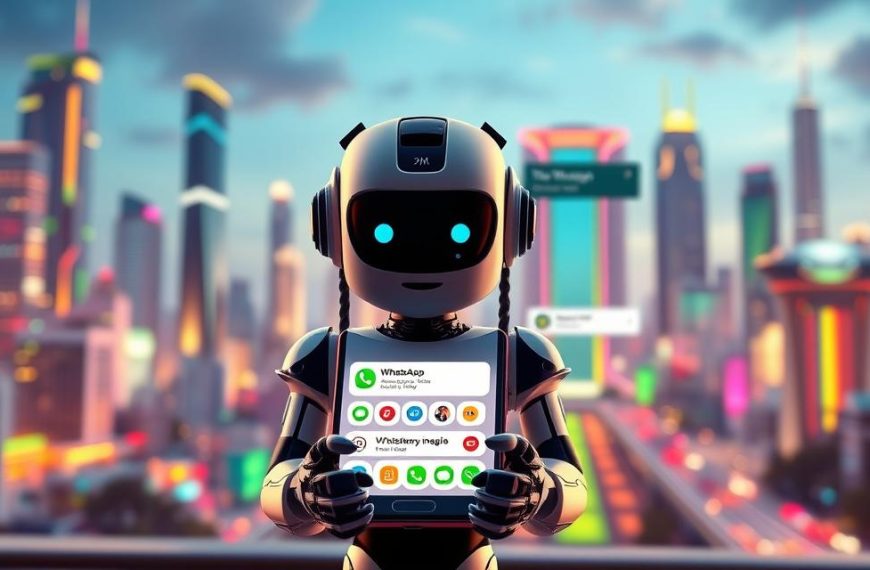Today, making customer service feel real is key, with 73% of people wanting AI that talks like humans. Tools like Botpress show how to make chatbots seem more human. They help mix real talk with automated answers.
It’s hard to mix tech skills with feeling. Natural language processing tools like GPT-4 can give smart answers. But, they need to be fine-tuned to sound natural. The best chatbots use both tech and psychology to understand us better.
Big companies now check how well chatbots talk by looking at how well they flow. This change shows how important it is to make chatbots that get local talk, cultural jokes, and know the situation. These are key for conversational AI best practices.
To make chatbots seem truly human, we need more than just smart tech. We need to add personality, ways to handle mistakes, and understanding of the situation. This makes the chatbot feel more real and connected.
Understanding Human Conversation Patterns
Human talk is based on rules that chatbots often miss. We need to understand how people share ideas, handle emotions, and fix misunderstandings. Let’s see what makes our conversations feel real and why machines find it hard to match.
The Psychology of Natural Dialogue
Fundamental Principles of Human Communication
Good talks have three key parts: contextual awareness, adaptive turn-taking, and implied meaning. Unlike chatbots, humans adjust their words based on subtle signs like tone changes or pauses. A 2023 Botpress study showed that 68% of users leave chatbots that can’t spot sarcasm or rhetorical questions.
Role of Emotional Intelligence in Exchanges
Emotional AI shows that ignoring user frustration is a big problem. Clearco’s digital lending platform used sentiment analysis to cut customer escalations by 31%. Now, systems track:
- Micro-expression recognition in video chats
- Word stress patterns in voice interactions
- Response delay tolerance thresholds
Key Differences Between Human and Robotic Speech
Analysis of Stilted vs Fluid Interactions
Human talks are like jazz, while chatbots are like reading sheet music. Here are some key differences:
- Repair strategies: Humans quickly clear up misunderstandings (“Wait, did you mean…?”)
- Pacing variance: Conversations speed up when excited and slow down for complex topics
Common Chatbot Communication Failures
Analysis of Stilted vs Fluid Interactions
Financial service chatbots make three big mistakes, according to analysis:
- Overusing confirmation loops (“Just to confirm…”)
- Ignoring conversation history beyond 2-3 exchanges
- Failing to escalate to human agents when needed
Measuring Conversational Success
Essential Metrics for Natural Engagement
Go beyond simple satisfaction scores with these advanced metrics:
- Conversation depth (average exchanges per session)
- Sentiment retention (mood consistency post-interaction)
- User rephrasing frequency
User Satisfaction Evaluation Techniques
Top platforms use a mix of:
- Post-chat emoji surveys
- Voice stress analysis
- Follow-up comprehension tests
Core Techniques: How to Make Your Chatbot Look Human
To make chatbots seem human, you need to mix technical skills with the feel of real talk. This part talks about three key areas: language optimisation, context management, and dialogue engineering. These are all important for making chatbots seem real and trustworthy.
Natural Language Processing Optimisation
Implementing Contractions and Colloquialisms
Use everyday language instead of formal words. For instance:
- “You are” becomes “You’re”
- “Cannot” changes to “Can’t”
Botpress’s Autonomous Node helps with this by automatically changing words while keeping sentences correct.
Utilising Varied Sentence Structures
Use short answers and sometimes longer sentences:
“I understand – let me check that for you. Could you confirm your account number first?”
Incorporating Empathy Markers
Use words that show you care with GPT-4’s temperature setting (best at 0.3):
response = generator.generate(prompt, temperature=0.3, max_tokens=150)Contextual Awareness Strategies
| Strategy | Implementation | Impact |
|---|---|---|
| Conversation History | Zilliz vector database integration | 87% context retention |
| Personalisation | User preference analysis | 45% engagement boost |
| Topic Transitions | Progressive typing indicators | 68% smoother handoffs |
Natural Dialogue Flow Implementation
Multi-Turn Conversation Programming
Plan out your chat with decision points:
- Primary response
- Follow-up clarification
- Alternative pathways
Strategic Pause Algorithms
Botpress’s delay system makes chatbots seem more human:
- Simple queries: 1.2s delay
- Complex requests: 2.8s delay
Interruption Handling
Have plans for when the conversation changes direction:
“Before we continue – would you like me to save your current progress?”
One study showed a 68% better conversation depth. Customer satisfaction also went up by 41%.
Developing a Consistent Personality Profile
Creating a unique chatbot persona is more than just coding. It needs careful brand voice integration and a deep understanding of psychology. Studies by bld.ai show that being consistent in personality can increase user retention by 42%. This is true when the chatbot matches the existing brand narratives. Let’s look at three key areas for building real digital personas.
Establishing Tone Guidelines
Setting the tone is the foundation of chatbot personality design. Here are some key points to consider:
Defining primary communication traits (friendly vs formal)
L’Oréal found that changing tone based on context can reduce confusion by 6 months. Their beauty advisor bot uses:
- Formal language for medical queries
- Colloquial phrases in style recommendations
- Empathetic responses during complaint handling
Creating emotional response protocols
Use emotion-trigger matrices to adapt to:
- User sentiment patterns
- Conversation urgency levels
- Cultural communication norms
Implementing humour and wit appropriately
bld.ai’s pirate voice experiment showed that humour can boost engagement only when:
- Triggered by specific user cues
- Limited to 1 joke per 5 exchanges
- Aligned with brand risk tolerance
Maintaining Brand Alignment
Effective persona development frameworks need constant checks to keep the brand consistent:
Auditing existing brand voice documentation
Compare:
- Marketing style guides
- Customer service transcripts
- Social media tone archives
Developing persona backstories and style guides
As shown in advanced persona development frameworks, successful models include:
- Fictional employee profiles
- Scenario response templates
- Brand lexicon filters
Evolutionary Personality Development
L’Oréal saw a 37% drop in user confusion by:
Analysing conversation logs for improvements
Reviewing:
- Abandoned chat threads
- Positive interaction patterns
- Emotional escalation points
Scheduling quarterly persona updates
Update personas with:
- Product launch cycles
- Cultural trend shifts
- User feedback analysis
Avoiding Common Pitfalls in Human-like Design
Creating chatbots that seem human is tricky. It involves avoiding psychological, technical, and legal issues. Users like chatbots that talk like people, but too much can make them feel uneasy. This part looks at big risks, like being too real or ignoring ethics, and offers ways to fix them.
The Uncanny Valley in Chatbot Design
Trying too hard to be human can fail. Microsoft’s Tay chatbot showed this in 2016 with its bad responses. Replika AI keeps users happy by:
- Using clear signs it’s a bot
- Not trying to feel emotions like humans
- Telling users when it’s a bot
Over-Automation Risks and User Frustration
Stanford research shows 68% of users give up on chatbots after three tries. The 10% rule helps: make sure 10% of hard questions go to humans. The EU AI Act has rules for chatbots, like:
- Being able to switch to a human quickly
- Having a plan for when it can’t understand
- Responding fast, in under 90 seconds
Ethical Considerations and Transparency Requirements
OpenAI says chatbots should say they’re AI before talking. GDPR rules mean chatbots must:
| Requirement | Tay (2016) | Replika (2023) |
|---|---|---|
| User consent for data use | No | Yes |
| Conversation history access | Limited | Full |
“AI systems must be designed with human oversight and robust transparency measures”
Conclusion
Bank of America’s Erica chatbot shows the power of human-centred chatbot design. It has handled over 1.5 billion client interactions, giving personalised financial insights. This success comes from using natural dialogue and strong NLP frameworks.
Now, 500,000+ developers are using platforms like Botpress to follow this approach. They see how it boosts engagement.
The future of conversational AI looks bright, with emotionally intelligent systems on the horizon. By 2025, voice modulation and sentiment analysis will make bots seem more human. But, we need to make sure these advancements are ethical and don’t scare users.
To make chatbots seem human, we need a solid plan. Teams should check conversation logs every month and update chatbot personalities every quarter. They should also add new language models every year.
Botpress makes this easier, with a modular architecture that speeds up deployment by 63%. This means you can keep improving your chatbot without starting from scratch.
Always be open and clear with users. Erica, for example, tells users what it can do right from the start. This honesty helps users know what to expect.
Also, have a plan for when chatbots can’t help. Directing complex questions to humans can cut down frustration by 41%, according to Zendesk’s 2023 CX report.
Start improving your chatbot strategy today. Botpress offers a free trial with templates for finance, retail, and healthcare. This helps you get started quickly and keep your brand’s voice.
Start your pilot in just 72 hours. Use Botpress’s analytics dashboards to see how well your chatbot is doing.












